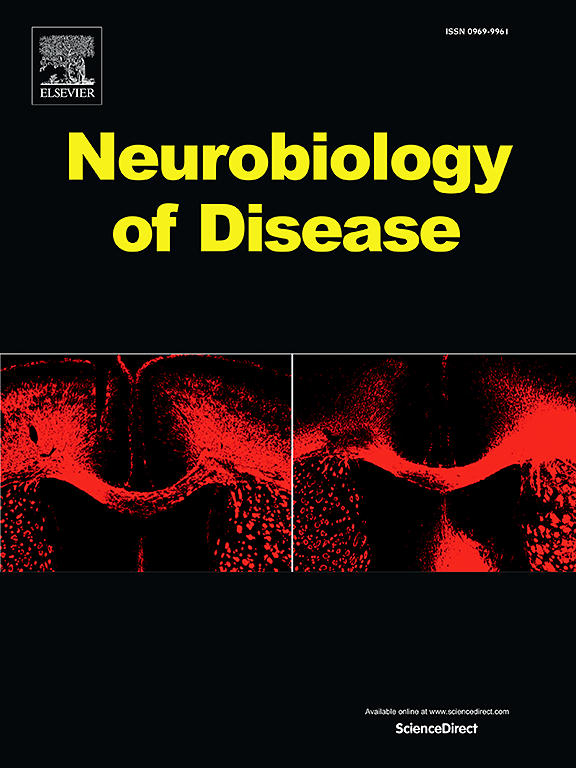自闭症小鼠Shank3突变模型中一阶和高阶丘脑网状神经元的亚型特异性改变
IF 5.6
2区 医学
Q1 NEUROSCIENCES
引用次数: 0
摘要
丘脑网状核(TRN)是丘脑皮质网络中一个重要的抑制结构,在感觉加工、注意力、认知灵活性和睡眠节律中起关键作用;重要的是,这些功能在自闭症谱系障碍(ASD)中发生了改变。TRN主要由两个神经元亚群组成:一阶神经元(FO)调节感觉中继核,高阶神经元(HO)控制丘脑联合回路。TRN-FO神经元位于核心区域,表现出重复性突发放电的高表达,并且已知有助于慢波振荡。相反,支配HO丘脑核的神经元位于TRN的前部和外周区域,并且具有较少的突发放电。这些亚群提供了对丘脑的特殊抑制,但它们在ASD中的改变很少被探索。我们评估了Shank3 KO小鼠丘脑核的网状抑制系统(FO和HO), Shank3 KO是一种完善的ASD单基因模型。我们分析了目标TRN神经元的电生理特性,我们的结果表明,TRN神经元投射到FO和HO核在Shank3 KO小鼠中表现出不同的变化,包括FO投射神经元的突发放电减少,这对维持睡眠结构至关重要。此外,我们还在丘脑腹后内侧核(vvm - fo)和后内侧核(POm-HO)中检测了自发和微型抑制性突触后电流(IPSCs)。我们发现VPM中自发IPSCs的频率降低,但mIPSCs没有变化。另一方面,在POm神经元中,我们观察到sIPSCs和mIPSCs的频率都降低了。总之,我们的研究结果显示,Shank3 KO小鼠中FO和HO丘脑核的抑制控制发生了明显的变化,这可能导致ASD中观察到的睡眠和感觉加工缺陷。本文章由计算机程序翻译,如有差异,请以英文原文为准。

Subtype-specific alterations in first- and higher-order thalamic reticular neurons in the Shank3 mutant mouse model of autism
The thalamic reticular nucleus (TRN) is a critical inhibitory structure in the thalamocortical network, playing key roles in sensory processing, attention, cognitive flexibility, and sleep rhythms; importantly these functions are altered in autism spectrum disorder (ASD). The TRN consists mainly of two neuronal subpopulations: first order (FO) neurons, which modulate sensory relay nuclei, and higher-order (HO) neurons, which control associative thalamic circuits. TRN-FO neurons are located in the core region, show a high expression of repetitive burst firing, and are known to contribute to slow-wave oscillations. In contrast, neurons innervating HO thalamic nuclei are in the anterior and peripheral regions of the TRN and have fewer burst firing. These subpopulations provide specialized inhibition to thalamus, but their alterations in ASD have rarely been explored. We evaluated the reticular inhibitory system in thalamic nuclei (FO and HO) in Shank3 KO mice, a well-established monogenic model of ASD. We analyzed electrophysiological properties of targeted TRN neurons, our results show that TRN neurons projecting to FO and HO nuclei exhibit differential changes in Shank3 KO mice, including decreased burst firing in FO projecting neurons, which is crucial for maintaining sleep architecture. Additionally, we examined spontaneous and miniature inhibitory postsynaptic currents (IPSCs), in ventroposteromedial (VPM-FO) and posteromedial (POm-HO) thalamic nuclei. We show a reduction in frequency of spontaneous IPSCs and mIPSCs in VPM and POm. Together, our results show distinct alterations in the inhibitory control of FO and HO thalamic nuclei in Shank3 KO mice, which could contribute to the deficits in sleep and sensory processing observed in ASD.
求助全文
通过发布文献求助,成功后即可免费获取论文全文。
去求助
来源期刊

Neurobiology of Disease
医学-神经科学
CiteScore
11.20
自引率
3.30%
发文量
270
审稿时长
76 days
期刊介绍:
Neurobiology of Disease is a major international journal at the interface between basic and clinical neuroscience. The journal provides a forum for the publication of top quality research papers on: molecular and cellular definitions of disease mechanisms, the neural systems and underpinning behavioral disorders, the genetics of inherited neurological and psychiatric diseases, nervous system aging, and findings relevant to the development of new therapies.
 求助内容:
求助内容: 应助结果提醒方式:
应助结果提醒方式:


